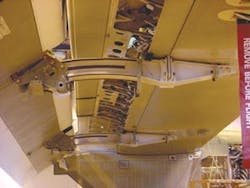High Velocity Oxygen Fuel Coatings: A way to extend component life
As far as coating processes go, there have been several traditional methods such as plating that have been used extensively in the aviation industry. But there is a fairly new process available that offers an option to these traditional coating processes. It can result in several benefits including quicker turn time and a harder, more corrosion-resistant coating. This process is high velocity oxygen fuel (HVOF) coating. Various materials can be applied using a HVOF process. In this article, we will take a look at the HVOF tungsten carbide coating process and how it can affect the components you are sending in for overhaul and repair.
Through extensive performance testing, and an increasing number of successful commercial applications, the performance advantages of HVOF tungsten carbide coatings have been demonstrated for a variety of aviation engine and airframe components (including aircraft flap tracks, landing gear, actuators, jet engine bearings, and even some dynamic components, such as helicopter drive trains and propeller assemblies). Able to provide improved wear, impact and fatigue resistance, and equal or better corrosion resistance, these new coatings have emerged as an alternative to electroless nickel coatings that are typically used on wing flap tracks, and to conventional hard chrome plating that is used for other aviation and engine components.
HVOF tungsten carbide coatings can be particularly useful to rebuild or repair worn or corroded components that have been removed from the aircraft during routine maintenance and overhaul activities. In particular, the dimensional integrity of airplane flap tracks, which often suffer damage during service, can be restored using this advanced coating.
How it works
HVOF is a thermal spray process. This thermal spray application is used to deposit tungsten carbide coatings directly to the part being repaired.
In HVOF application, fuel gas is fed at high pressure into the combustion chamber of a special nozzle, where it burns to produce a hot, high-pressure gas stream. Tungsten carbide powder particles are then injected into this gas stream. The stream is then directed toward the substrate being coated, to create a dense, durable coating with less than 1 percent porosity. Since the combustion temperature of this process is around 5,000 F and nozzle exit velocities can reach up to 4,500 feet per second, the HVOF coating process is typically carried out in a spray booth, using a robotic apparatus.
Unlike the electrolytic process that is used to apply hard chrome plating, the HVOF process creates no contaminated waste or rinse-water streams to be disposed of later, and it eliminates potential worker exposure to hexavalent chrome. It is also faster than chrome plating (with typical coating deposition possible in an hour or two, vs. 24 hours required for hard chrome plating). And, HVOF tungsten carbide coatings do not suffer from hydrogen embrittlement (as can hard chrome coatings), so the time and cost required for embrittlement-relief treatment is eliminated. All of these factors work in tandem to lower the frequency of repairs and facilitate faster turnaround during overhaul and maintenance activities (which reduces out-of-service time), thereby reducing the overall lifecycle costs associated with these critical parts.
Gaining in commercial acceptance
Engelhard offers a complete overhaul and repair service, using HVOF tungsten carbide coatings to restore the dimensional integrity of the flap track sets used on DHC-8 aircraft. This service meets the specifications and requirements of the aircraft's manufacturer, Bombardier. By demonstrably improving the flap track's ability to withstand abrasive and corrosive damage from cavitation and vibration, and exposure to salt and moisture, the HVOF tungsten carbide coatings have been credited with extending the service life of these critical structural wing components by an additional 20,000 to 40,000 cycles (one cycle represents one takeoff and one landing) since they went into use about two years ago. Operators such as Horizon Air and Wideroe Airlines are realizing a positive financial payback by using HVOF tungsten carbide coatings to restore the dimensional integrity of the flap track sets on their DHC-8 aircraft.
Today, many other commercial and military aviation companies, and the U.S. Dept. of Defense are actively evaluating (and approving) the use of HVOF tungsten carbide coatings as an advanced coating for various engine and airframe components. With their ability to impart superior resistance to abrasion and wear, fatigue failure, and corrosive attack, and to help operators sidestep the costs, hazards, and potential liabilities associated with using electrolytic chrome plating processes, demand for HVOF tungsten carbide coatings is expected to soar in the years to come ? just like the complex aircraft they protect. AMT
